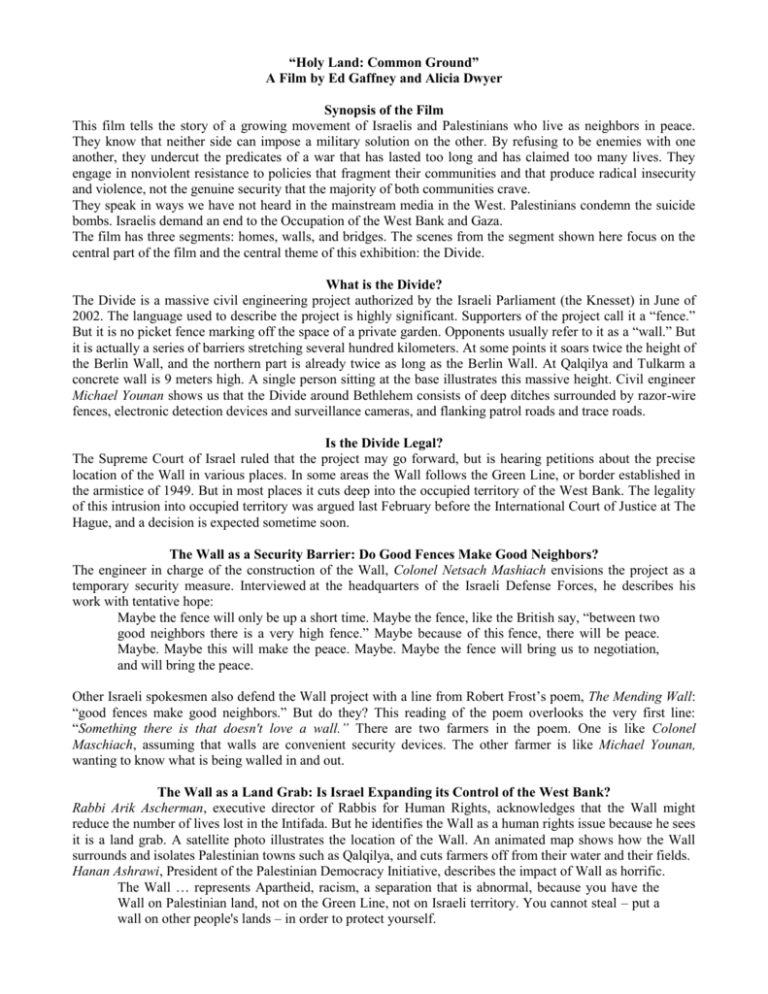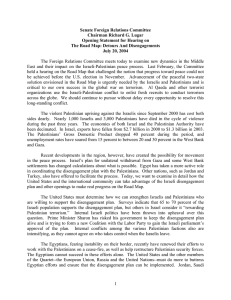Holy Land: Common Ground
advertisement

“Holy Land: Common Ground” A Film by Ed Gaffney and Alicia Dwyer Synopsis of the Film This film tells the story of a growing movement of Israelis and Palestinians who live as neighbors in peace. They know that neither side can impose a military solution on the other. By refusing to be enemies with one another, they undercut the predicates of a war that has lasted too long and has claimed too many lives. They engage in nonviolent resistance to policies that fragment their communities and that produce radical insecurity and violence, not the genuine security that the majority of both communities crave. They speak in ways we have not heard in the mainstream media in the West. Palestinians condemn the suicide bombs. Israelis demand an end to the Occupation of the West Bank and Gaza. The film has three segments: homes, walls, and bridges. The scenes from the segment shown here focus on the central part of the film and the central theme of this exhibition: the Divide. What is the Divide? The Divide is a massive civil engineering project authorized by the Israeli Parliament (the Knesset) in June of 2002. The language used to describe the project is highly significant. Supporters of the project call it a “fence.” But it is no picket fence marking off the space of a private garden. Opponents usually refer to it as a “wall.” But it is actually a series of barriers stretching several hundred kilometers. At some points it soars twice the height of the Berlin Wall, and the northern part is already twice as long as the Berlin Wall. At Qalqilya and Tulkarm a concrete wall is 9 meters high. A single person sitting at the base illustrates this massive height. Civil engineer Michael Younan shows us that the Divide around Bethlehem consists of deep ditches surrounded by razor-wire fences, electronic detection devices and surveillance cameras, and flanking patrol roads and trace roads. Is the Divide Legal? The Supreme Court of Israel ruled that the project may go forward, but is hearing petitions about the precise location of the Wall in various places. In some areas the Wall follows the Green Line, or border established in the armistice of 1949. But in most places it cuts deep into the occupied territory of the West Bank. The legality of this intrusion into occupied territory was argued last February before the International Court of Justice at The Hague, and a decision is expected sometime soon. The Wall as a Security Barrier: Do Good Fences Make Good Neighbors? The engineer in charge of the construction of the Wall, Colonel Netsach Mashiach envisions the project as a temporary security measure. Interviewed at the headquarters of the Israeli Defense Forces, he describes his work with tentative hope: Maybe the fence will only be up a short time. Maybe the fence, like the British say, “between two good neighbors there is a very high fence.” Maybe because of this fence, there will be peace. Maybe. Maybe this will make the peace. Maybe. Maybe the fence will bring us to negotiation, and will bring the peace. Other Israeli spokesmen also defend the Wall project with a line from Robert Frost’s poem, The Mending Wall: “good fences make good neighbors.” But do they? This reading of the poem overlooks the very first line: “Something there is that doesn't love a wall.” There are two farmers in the poem. One is like Colonel Maschiach, assuming that walls are convenient security devices. The other farmer is like Michael Younan, wanting to know what is being walled in and out. The Wall as a Land Grab: Is Israel Expanding its Control of the West Bank? Rabbi Arik Ascherman, executive director of Rabbis for Human Rights, acknowledges that the Wall might reduce the number of lives lost in the Intifada. But he identifies the Wall as a human rights issue because he sees it is a land grab. A satellite photo illustrates the location of the Wall. An animated map shows how the Wall surrounds and isolates Palestinian towns such as Qalqilya, and cuts farmers off from their water and their fields. Hanan Ashrawi, President of the Palestinian Democracy Initiative, describes the impact of Wall as horrific. The Wall … represents Apartheid, racism, a separation that is abnormal, because you have the Wall on Palestinian land, not on the Green Line, not on Israeli territory. You cannot steal – put a wall on other people's lands – in order to protect yourself. This is land theft, because they're stealing the fertile agricultural area. This is theft of resources, they've already stolen over 21 wells, underground water. This is separation of the Palestinians from their own land, from their own livelihood, and at the same time it besieges whole towns, whole areas, and creates isolated enclaves, or ghettos, for the Palestinians, on their own land. The Wall as an Obstacle to Peace: The End of the Two-State Solution? Dr. Ashrawi also fears that the Wall will end the possibility of a Two-State solution: It just epitomizes, it encapsulates the ugliness of the Occupation, it encapsulates all the different aspects in which the Occupation attempts to besiege, on the one hand, the Palestinians, and on the other to prevent any kind of reaching out, any kind of genuine reconciliation. Israel would have created facts on the ground that render the creation of a viable Palestinian State impossible, and it would create the grounds for further hatred, further hostility, further conflict. Do Physical Barriers Work? Senator George Mitchell, Chair of the Peace Negotiation in Northern Ireland, saw the futility of the “Peace Line,” a barrier dividing Protestants from Catholics in Belfast. He acknowledges that life has become unbearable for both Palestinians and Israelis, but insists that “there is no such thing as a conflict that can’t be resolved.” And he concludes: “The Middle East conflict, like all other conflicts, is made, sustained and conducted by human beings; and like all other conflicts it can be resolved by human beings.” “First of All, the Wall Must Fall” The White House has told Israel that it will not pay for the construction of the Wall. On 25 July 2003 President Bush stated: “It is very difficult to develop confidence between the Palestinians and Israel with a wall snaking through the West Bank.” But President Bush has not spoken with the clarity of the four strong words proclaimed by President Reagan at the Berlin Wall: “Tear down this wall!” The film documents a series of demonstrations by Israelis, Palestinians, and Internationals chanting in Hebrew and English “First of all, the wall must fall!” They protest against the swath of destruction and division left behind when the bulldozers move on to another phase of the Divide. Far from achieving the security that Israelis most crave, these voices insist, the Wall epitomizes and fuels the cycle of violence in which both sides have been trapped. Is There a Way Out? Bridging the Divide Rev. Munib Younan, Lutheran Bishop of Jerusalem, states: “I am worried about walls of hatred, bitterness, despair, revenge that are growing higher and higher every day…. Here is the work of the church…. How can we bring down these walls?” In the summer of 2003 the famous pianist and conductor Daniel Barenboim went to Ramallah to begin the formation of a Palestinian orchestra. He and his friend Edward Said, the late Palestinian scholar and lover of music, have for years sponsored a project to bring young Israeli and Palestinian artists together in the summer to learn to make music together. At a news conference in Ramallah Barenboim stated: “What the region needs is more bridge-builders, not wall-builders.” The remainder of our film will describe the efforts of prominent peacemakers in both societies. These peacemakers build bridges of understanding, not walls of division and hatred. They come together to support grief-stricken families in both communities who suffer the loss of an innocent child killed in a senseless war. They cross lines and barriers to protest against a Wall snaking in and out of the West Bank. They rebuild demolished homes. Soldiers lay down their arms rather than take part in oppressive acts they know will provoke resentment and rage. Physicians cross borders to deliver health care to isolated towns and villages. They persist in hope for a wise resolution of this conflict, but they are not waiting for politicians to deliver what they already have: the ability to live in peace with the other. They seek not another protracted peace process, but a genuine and lasting peace based on simple justice and forgiveness, without which there can be no future. They have respect for different faiths and cultures in the Holy Land, but the common ground on which they stand together is their common humanity. Archbishop Desmond Tutu invites the viewer to see the future with hope. He speaks not in the tones of a Polyanna, but with the credibility of a freedom fighter who overcame the injustice of apartheid without succumbing to the use of violence: “If peace can happen in South Africa, we say it can happen anywhere. Peace can break out in the Middle East. It can happen. It will happen.” For further information about “Holy Land: Common Ground,” contact Ed Gaffney at edward.gaffney@valpo.edu











